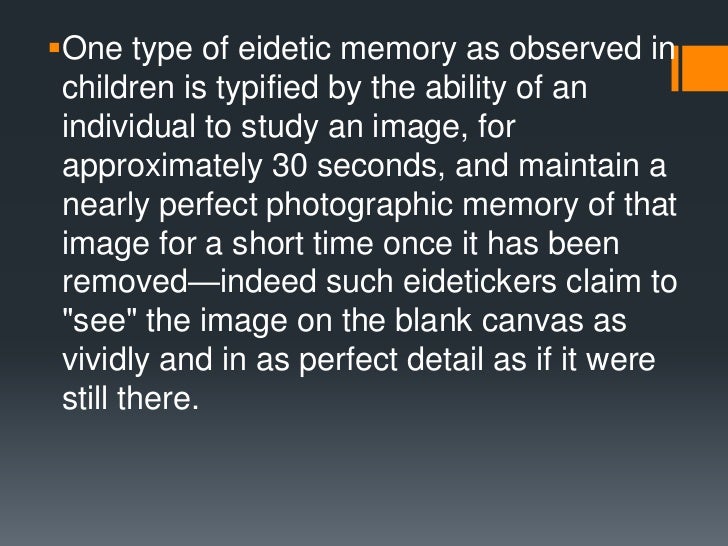

In fact, most claims of true eidetic or photographic memory are merely word-of-mouth reports that haven't been proven scientifically. Some scientists have observed that individuals with autism or autism spectrum disorders, such as Asperger syndrome, may occasionally exhibit exceptional memory that resembles eidetic or photographic memory.įor the most part, though, extraordinary memory events are just that - extraordinary, but not necessarily up to the level of eidetic or photographic memory. People who can do this - sometimes called eidetickers - claim that they can “see" the image in their minds as if it was still right before their eyes. One example of eidetic memory is the ability to study an image for about 30 seconds and keep an almost-perfect photographic memory of that image in the mind after it's removed. Eidetic memory, on the other hand, refers to precise recall that can involve details gained from the other senses, such as hearing, feeling, taste, and smell. Photographic memory often refers to precise recall of mainly visual images. The word “eidetic" comes from the Greek word that means “seen." Eidetic memory is actually broader than photographic memory. Photographic memory is the common name for eidetic memory. This means they can recall things they've seen or read with almost-perfect precision, even down to the smallest of details.

Some people even claim to have a photographic memory.

Have you ever gotten down to the last couple of questions on a test, but you just can't seem to remember the answer? At these times, you probably wish you could see the pages of your textbook like a photograph in your memory.ĭo you know someone who has a really good memory? Some people are gifted in special ways when it comes to exceptional memory. Sometimes you might wish you had a better memory. Scientists are learning more about memory by studying these people, as well as people who have very poor memory as the result of neurological injury or disease.Do you like tests? If you're like most kids, the answer is probably a resounding “No!" Tests can be a lot of work, especially in subjects like history that have a ton of facts to remember. Others are able to effortlessly recall vast amounts of autobiographical information spanning most of the lifetime. Some people with excellent memory use elaborate techniques to help them remember. Additionally, the extent to which we replay the material in our minds and relate it to what we already know affects our ability to remember. How well we remember things depends largely on how well we pay attention when material is presented. Of course, people vary in their ability to remember the past. This is advantageous because what is important for memory is the meaning of what was presented, not the exact details present at any given time. We are good at remembering the gist of what happened and less good at remembering (photographically) all the elements of a past scene. Passing over details helps us to form general concepts. To recollect a past event, we piece together various remembered elements and typically forget parts of what happened (the color of the wall, the picture in the background, the exact words that were said). Memory is more like pieces of a jigsaw puzzle than a photograph. If memory worked like a photograph, these people would be able to rapidly reproduce the text in reverse order by "reading" the photo. It is easy to demonstrate this by asking people who think they have photographic memory to read two or three lines of text and then report the text in reverse order. However, photographic memory does not exist in this sense. Just as a photograph freezes a moment in time, the implication for people thought to have photographic memory is that they can take mental snapshots and then recall these snapshots without error. Photographic memory is a term often used to describe a person who seems able to recall visual information in great detail.


 0 kommentar(er)
0 kommentar(er)
